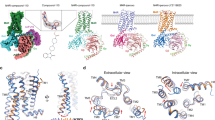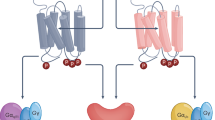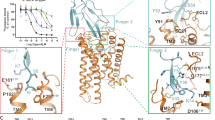Abstract
Alterations in muscarinic acetylcholine receptor (CHRM) populations have been implicated in the pathology of schizophrenia. Here we have assessed whether the receptor function of the M1 subtype (CHRM1) is altered in a sub-population of patients with schizophrenia, defined by marked (60–80%) reductions in cortical [3H]-pirenzepine (PZP) binding, and termed ‘muscarinic receptor-deficit schizophrenia’ (MRDS). Using a [35S]-GTPγS-Gαq/11 immunocapture method we have assessed whether CHRM1 signalling in human cortex (Brodmann area 9 (BA9)) is altered in post mortem tissue from a MRDS group compared with a subgroup of patients with schizophrenia displaying normal PZP binding, and controls with no known history of psychiatric or neurological disorders. The CHRM agonist (oxotremorine-M) and a CHRM1-selective agonist (AC-42) increased Gαq/11-[35S]-GTPγS binding, with AC-42 producing responses that were ∼50% of those maximally evoked by the full agonist, oxotremorine-M, in control and subgroups of patients with schizophrenia. However, the potency of oxotremorine-M to stimulate Gαq/11-[35S]-GTPγS binding was significantly decreased in the MRDS group (pEC50 (M)=5.69±0.16) compared with the control group (6.17±0.10) and the non-MRDS group (6.05±0.07). The levels of Gαq/11 protein present in BA9 did not vary with diagnosis. Maximal oxotremorine-M-stimulated Gαq/11-[35S]-GTPγS binding in BA9 membranes was significantly increased in the MRDS group compared with the control group. Similar, though non-statistically significant, trends were observed for AC-42. These data provide evidence that both orthosterically and allosterically acting CHRM agonists can stimulate a receptor-driven functional response ([35S]-GTPγS binding to Gαq/11) in membranes prepared from post mortem human dorsolateral prefrontal cortex of patients with schizophrenia and controls . Furthermore, in a subgroup of patients with schizophrenia displaying markedly decreased PZP binding (MRDS) we have shown that although agonist potency may decrease, the efficacy of CHRM1-Gαq/11 coupling increases, suggesting an adaptative change in receptor-G protein coupling efficiency in this endophenotype of patients with schizophrenia.
Similar content being viewed by others
Log in or create a free account to read this content
Gain free access to this article, as well as selected content from this journal and more on nature.com
or
References
American Psychiatric Association (2000). Diagnostic and Statistical Manual of Mental Disorders 4th edn. text revision American Psychiatric Association: Washington, DC.
Akam EC, Challiss RAJ, Nahorski SR (2001). Gq/11 and Gi/o activation profiles in CHO cells expressing human muscarinic acetylcholine receptors: dependence on agonist as well as receptor-subtype. Br J Pharmacol 132: 950–958.
Anagnostaras SG, Murphy GG, Hamilton SE, Mitchell SL, Rahnama NP, Nathanson NM et al (2003). Selective cognitive dysfunction in acetylcholine M1 muscarinic receptor mutant mice. Nat Neurosci 6: 51–58.
Caulfield MP, Birdsall NJM (1998). International Union of Pharmacology. XVII. Classification of muscarinic acetylcholine receptors. Pharmacol Revs 50: 279–290.
Crook JM, Tomaskovic-Crook E, Copolov DL, Dean B (2000). Decreased muscarinic receptor binding in subjects with schizophrenia: a study of the human hippocampal formation. Biol Psychiatry 48: 381–388.
Crook JM, Tomaskovic-Crook E, Copolov DL, Dean B (2001). Low muscarinic receptor binding in prefrontal cortex from subjects with schizophrenia: a study of Brodmann's areas 8, 9, 10 and 46 and the effects of neuroleptic drug treatment. Am J Psychiatry 158: 918–925.
DeLapp NW, McKinzie JH, Sawyer BD, Vandergriff A, Falcone J, McClure D et al (1999). Determination of [35S]guanosine-5′-O-(3-thio)triphosphate binding mediated by cholinergic muscarinic receptors in membranes from Chinese hamster ovary cells and rat striatum using an anti-G protein scintillation proximity assay. J Pharmacol Exp Ther 289: 946–955.
De Lean A, Stadel JM, Lefkowitz RJ (1980). J Biol Chem 255: 7108–7117.
Dean B, Crook JM, Opeskin K, Hill C, Keks N, Copolov DL (1996). The density of muscarinic M1 receptors is decreased in the caudate-putamen of subjects with schizophrenia. Mol Psychiatry 1: 54–58.
Dean B, McLeod M, Keriakous D, McKenzie J, Scarr E (2002). Decreased muscarinic1 receptors in the dorsolateral prefrontal cortex of subjects with schizophrenia. Mol Psychiatry 7: 1083–1091.
Deng C, Huang XF (2005). Decreased density of muscarinic receptors in the superior temporal gyrusin schizophrenia. J Neurosci Res 81: 883–890.
Gale EA (2001). The discovery of type 1 diabetes. Diabetes 50: 217–226.
Hamilton SE, Loose MD, Qi M, Levey AI, Hille B, McKnight GS et al (1997). Disruption of the m1 receptor gene ablates muscarinic receptor-dependent M current regulation and seizure activity in mice. Proc Natl Acad Sci USA 94: 13311–13316.
Hersch SM, Levey AI (1995). Diverse pre- and post-synaptic expression of m1-m4 muscarinic receptor proteins in neurons and afferents in the rat neostriatum. Life Sci 56: 931–938.
Hill C, Keks N, Roberts S, Opeskin K, Dean B, Copolov D (1999). Diagnostic Instrument for Brain Studies. Mental Health Research Institute: Melbourne.
Hyde TM, Crook JM (2001). Cholinergic systems and schizophrenia: primary pathology or epiphenomena? J Chem Neuroanat 22: 53–63.
Kenakin TP (2006). Agonists: the measurement of affinity and efficacy in functional assays. In: ‘A Pharmacology Primer: Theory, Application and Methods’, 2nd edn. Academic Press/Elsevier. pp 79–98.
Kingsbury AE, Foster OJ, Nisbet AP, Cairns N, Bray L, Eve DJ et al (1995). Tissue pH as an indicator of mRNA preservation in human post-mortem brain. Mol Brain Res 28: 311–318.
Langmead CJ, Fry VA, Forbes IT, Branch CL, Christopoulos A, Wood MD et al (2006). Probing the molecular mechanism of interaction between 4-n-butyl-1-[4-(2-methylphenyl)-4-oxo-1-butyl]-piperidine (AC-42) and the muscarinic M1 receptor: direct pharmacological evidence that AC-42 is an allosteric agonist. Mol Pharmacol 69: 236–246.
Langmead CJ, Christopoulos A (2006). Allosteric agonists of 7TM receptors: expanding the pharmacological toolbox. Trends Pharmacol Sci 27: 475–481.
Levey AI, Kitt CA, Simonds WF, Price DL, Brann MR (1991). Identification and localization of muscarinic acetylcholine receptor proteins in brain with subtype-specific antibodies. J Neurosci 11: 3218–3226.
López de Jesús M, Zalduegui A, Ruiz de Azúa I, Callado LF, Meana JJ, Sallés J (2006). Levels of G-protein αq/11 subunits and of phospholipase C-β1-4, -γ, and -δ1 isoforms in post mortem human brain caudate and cortical membranes: potential functional implications. Neurochem Int 49: 72–79.
Mancama D, Arranz MJ, Landau S, Kerwin R (2003). Reduced expression of the muscarinic 1 receptor cortical subtype in schizophrenia. Am J Med Genet 119: 2–6.
Pantelis C, Barber FZ, Barnes TR, Nelson HE, Owen AM, Robbins TW (1999). Comparison of set-shifting ability in patients with chronic schizophrenia and frontal lobe damage. Schizophrenia Res 37: 251–270.
Perlstein WM, Carter CS, Noll DC, Cohen JD (2001). Relation of prefrontal cortex dysfunction to working memory and symptoms in schizophrenia. Am J Psychiatry 158: 1105–1113.
Raedler TJ, Knable MB, Jones DW, Urbina RA, Gorey JG, Lee KS et al (2003). In vivo determination of muscarinic acetylcholine receptor availability in schizophrenia. Am J. Psychiatry 160: 118–127.
Raedler TJ, Bymaster FP, Tandon R, Copolov D, Dean B (2007). Towards a muscarinic hypothesis of schizophrenia. Mol Psychiatry 12: 232–246.
Raedler TJ (2007). Comparison of the in vivo muscarinic cholinergic receptor availability in patients treated with clozapine and olanzapine. Int J Neuropsychopharmacol 10: 275–280.
Ragland JD, Yoon J, Minzenberg MJ, Carter CS (2007). Neuroimaging of cognitive disability in schizophrenia: Search for a pathophysiological mechanism. Int Rev Psychiatry 19: 419–429.
Salah-Uddin H, Thomas DR, Davies CH, Hagan JJ, Wood MD, Watson JM et al (2008). Pharmacological assessment of M1 muscarinic acetylcholine receptor-Gq/11 protein coupling in membranes prepared from post mortem human brain tissue. J Pharmacol Exp Ther 325: 869–874.
Scarr E, Keriakous D, Crossland N, Dean B (2006). No change in cortical muscarinic M2, M3 receptors, or [35S]-GTPγS binding in schizophrenia. Life Sci 78: 1231–1237.
Scarr E, Sundram S, Keriakous D, Dean B (2007). Altered hippocampal muscarinic M4, but not M1, receptor expression from subjects with schizophrenia. Biol Psychiatry 61: 1161–1170.
Scarr E, Cowie TF, Kanellakis S, Sundram S, Pantelis C, Dean B (2008). Decreased cortical muscarinic receptors define a sub-group of subjects with schizophrenia. Mol Psychiatry, (advance online publication, 4 March 2008. Available at http://www.nature.com/mp/journal/vaop/ncurrent/pdf/mp200828a.pdf; doi:10.1038/mp.2008.28).
Shekhar A, Potter WZ, Lightfoot J, Lienemann J, Dubé S, Mallinckrodt C et al (2008). Selective muscarinic receptor agonist Xanomeline as a novel treatment approach for schizophrenia. Am J Psychiatry 165: 1033–1039.
Spalding TA, Trotter C, Skjaerbaek N, Messier TL, Currier EA, Burstein ES et al (2002). Discovery of an ectopic activation site on the M1 muscarinic receptor. Mol Pharmacol 61: 1297–1302.
Weiner DM, Levey AI, Brann MR (1990). Expression of muscarinic acetylcholine and dopamine receptor mRNAs in rat basal ganglia. Proc Natl Acad Sci USA 87: 7050–7054.
Wess J, Eglen RM, Gautam D (2007). Muscarinic acetylcholine receptor knockout mice: novel phenotypes and clinical implications. Nat Rev Drug Discov 6: 721–733.
Zavitsanou K, Katsifis A, Mattner F, Huang XF (2004). Investigation of m1/m4 muscarinic receptors in the anterior cingulate cortex in schizophrenia, bipolar disorder, and major depression disorder. Neuropsychopharmacology 29: 619–625.
Acknowledgements
We gratefully acknowledge Drs CH Davies and MD Wood (GlaxoSmithKline) for their comments on earlier drafts of the paper and Drs FJ Ehlert (University of California, Irvine, CA, USA) and JR Traynor (University of Michigan, Ann Arbor, MI, USA) for their discussions concerning the interpretation of curve-fitting data. This work was funded in part by a collaboration grant from GlaxoSmithKline (to RAJC). BD is an NHMRC Senior Research Fellow (Level B: 400016) and this work was supported in part by Operational Infrastructure Support (OIS) from the Victorian State Government. ES is a Royce Abbey Postdoctoral Fellow, supported by the Australian Rotary Health Research Fund.
Author information
Authors and Affiliations
Corresponding author
Additional information
DISCLOSURE/CONFLICT OF INTEREST
The authors have no financial or competing interests to declare, except that ES received travel support from GlaxoSmithKline (in 2007) and an honorarium for a clinical presentation from AstraZeneca (in 2005).
Rights and permissions
About this article
Cite this article
Salah-Uddin, H., Scarr, E., Pavey, G. et al. Altered M1 Muscarinic Acetylcholine Receptor (CHRM1)-Gαq/11 Coupling in a Schizophrenia Endophenotype. Neuropsychopharmacol 34, 2156–2166 (2009). https://doi.org/10.1038/npp.2009.41
Received:
Revised:
Accepted:
Published:
Issue date:
DOI: https://doi.org/10.1038/npp.2009.41
Keywords
This article is cited by
-
Involvement of muscarinic receptors in psychomotor hyperactivity in dopamine-deficient mice
Molecular Brain (2022)
-
Functional approaches to the study of G-protein-coupled receptors in postmortem brain tissue: [35S]GTPγS binding assays combined with immunoprecipitation
Pharmacological Reports (2021)
-
Functional coupling of M1 muscarinic acetylcholine receptor to Gαq/11 in dorsolateral prefrontal cortex from patients with psychiatric disorders: a postmortem study
European Archives of Psychiatry and Clinical Neuroscience (2020)
-
Changed gene expression in subjects with schizophrenia and low cortical muscarinic M1 receptors predicts disrupted upstream pathways interacting with that receptor
Molecular Psychiatry (2018)
-
Isoform specific differences in phospholipase C beta 1 expression in the prefrontal cortex in schizophrenia and suicide
npj Schizophrenia (2017)



